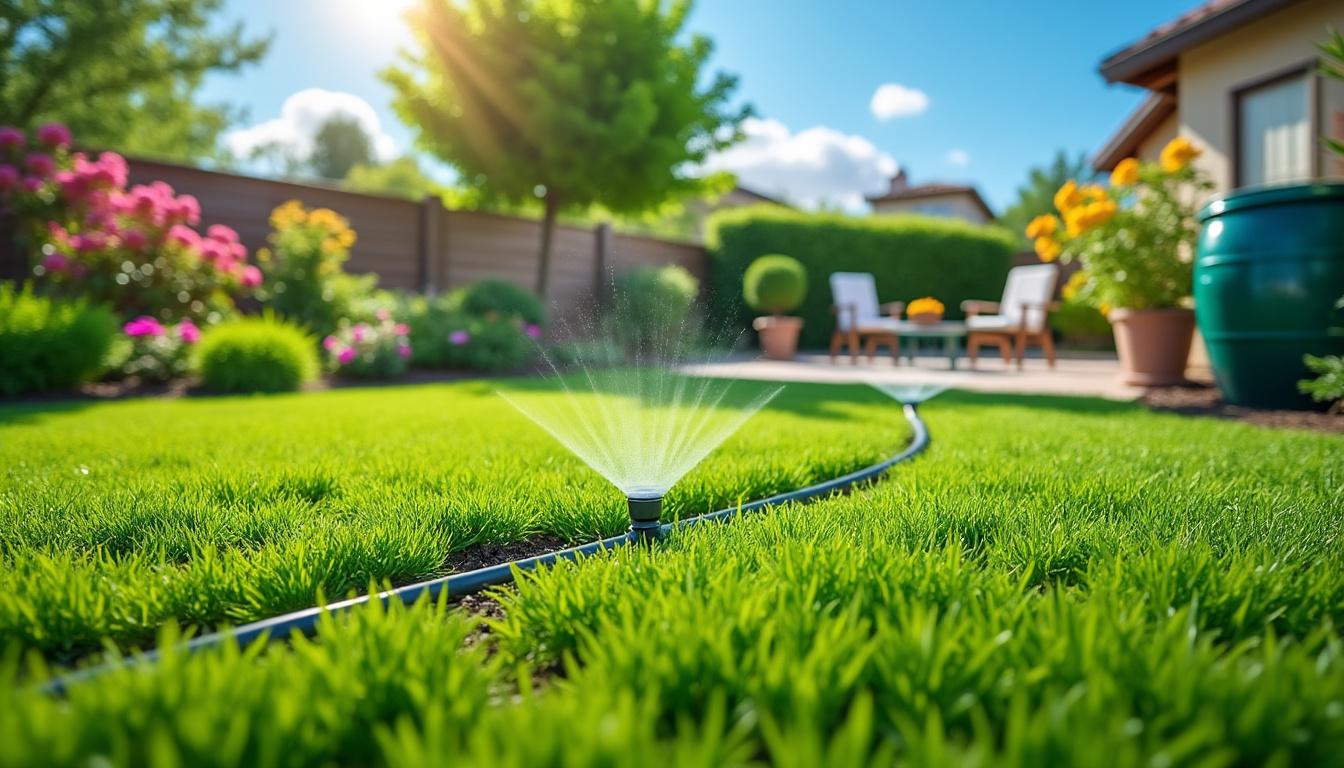Maintaining a lush, green lawn has become an increasingly complex challenge for homeowners today. As environmental concerns and water restrictions rise, the need to conserve water without sacrificing the vitality of residential landscapes is more important than ever. Homeowners grapple with balancing aesthetic desires against the reality of limited water resources and fluctuating utility costs. Innovative strategies and smarter technologies now provide effective solutions, allowing yards to flourish while using minimal water. Whether adapting to regional climates or making tactical adjustments in lawn care routines, embracing efficient watering practices delivers both environmental benefits and cost savings. This article explores sophisticated yet practical approaches that empower homeowners to sustain verdant lawns without waste, tapping into drought-resistant grasses, soil enhancement methods, and cutting-edge irrigation tools. By integrating these insights, property owners can confidently preserve the green spaces they treasure, turning water conservation into a seamless aspect of lawn management.
Selecting the Best Drought-Resistant Grass Types for Sustainable Lawn Care
One fundamental step toward reducing water usage while maintaining a green lawn is choosing grass species adapted to the local climate’s moisture availability. Traditional upright or water-demanding varieties often necessitate excessive irrigation, leading to inflated water bills and environmental strain. In contrast, drought-tolerant grasses are genetically equipped with deep root systems and physiological adaptations that require minimal watering.
Recommended drought-resistant grass species include:
- Bermuda Grass: Ideal for warm climates, this tough species withstands drought by closing stomata and reducing water loss.
- Buffalo Grass: Native to arid regions, it thrives with minimal rainfall, producing a blue-green turf with robust roots.
- Zoysia Grass: Heat-resistant and adaptable, Zoysia tolerates infrequent irrigation and resists pest invasions.
- Fescue Grass: Particularly fine fescue varieties excel in cooler zones, offering durability with less water need.
To facilitate selection, here is a comparative table illustrating the water requirements and resilience of common drought-resistant grasses:
| Grass Type | Best Climate | Water Need | Drought Tolerance | Maintenance Level |
|---|---|---|---|---|
| Bermuda Grass | Warm | Low to Moderate | High | Moderate |
| Buffalo Grass | Dry, Arid | Very Low | Very High | Low |
| Zoysia Grass | Warm to Temperate | Low | High | Moderate |
| Fescue Grass | Cool | Low | Moderate | Moderate |
Utilizing varieties like Bermuda or Zoysia reduces watering frequency dramatically, particularly in regions where summer droughts impact availability. For cool-season climates, fine fescues stand out as the most economical grass for water conservation. Notably, combining turf selection with complementary techniques like aeration and soil amendment amplifies water retention benefits. Resources from companies like Toro and Gardena offer guidance on integrating grasses suited to environmental conditions, enhancing water efficiency while maintaining dense, green lawns.
Watering Strategies That Maximize Lawn Health and Minimize Waste
Effective watering is pivotal when aiming to keep lawns vibrant without unnecessary water loss. Homeowners often fall into the trap of frequent shallow watering, which promotes weak root systems and encourages dependency on constant irrigation. Instead, adopting strategic watering principles ensures that grass receives adequate moisture deeply and efficiently.
Optimal Watering Frequency and Timing
Best practice is to water deeply but infrequently. Delivering approximately one inch of water once or twice per week encourages roots to extend downward in search of moisture, resulting in a more resilient lawn. Early morning watering between 4 a.m. and 10 a.m. is ideal since cooler temperatures and reduced wind decrease evaporation.
Tools for Precision Watering
- Soil Moisture Sensors: Devices from brands such as Rain Bird and Hunter monitor soil hydration, enabling irrigation only when necessary—minimizing waste.
- Smart Irrigation Controllers: Systems from EcoSmart and WaterWise automatically adjust watering schedules based on weather data and soil moisture.
- Efficient Sprinkler Heads: Sprinkler heads produced by Orbit and Gilmour ensure even water distribution that targets lawn areas without wetting sidewalks or driveways.
An accessible technique to measure watering adequacy involves placing an empty tuna can in the lawn while watering. Once the can collects about one inch of water, watering can be halted. This simple method helps homeowners avoid over-irrigation that leads to runoff and wasted water.
| Technique | Recommended Frequency | Water Amount per Session | Best Time to Water | Benefits |
|---|---|---|---|---|
| Deep Watering | 1-2 times weekly | 1 inch | Early Morning | Promotes deep root growth and drought resistance |
| Use of Soil Moisture Sensor | As needed | Varies | Automated | Prevents overwatering, saves water |
| Smart Controllers | Adaptive | Adaptive | Automated | Optimizes irrigation with weather awareness |
Employing such technologies aligns with water conservation mandates often implemented in urban environments. Homeowners benefits are significant, including reduced water bills and healthier, more drought-resistant turf. Combining automated irrigation with grass varieties recommended for the climate enhances lawn sustainability. Further financial assistance options for upgrading irrigation technologies can be explored at local utility assistance programs.
Enhancing Soil Quality to Boost Water Retention and Lawn Resilience
Soil health is a crucial, often overlooked factor influencing how efficiently lawns utilize water. Compacted or poor-quality soils repel water, leading to runoff, puddling, and root suffocation. Optimizing soil condition improves water infiltration and retention, dramatically diminishing irrigation needs.
Methods to Improve Soil for Water Conservation
- Aeration: Mechanics like lawn aerators pierce compacted soil layers allowing oxygen, water, and nutrients to penetrate roots more effectively. Seasonal aeration, typically twice yearly, prevents soil crusting.
- Incorporation of Organic Matter: Adding compost or organic mulches such as products offered by EarthBox increases soil’s moisture-holding capacity and fosters beneficial microbial activity.
- Top Dressing: Applying thin layers of peat moss or compost replenishes soil nutrients and improves texture, promoting better water absorption.
- Use of Mulch: Strategic mulching around lawn edges and garden beds reduces surface evaporation, maintaining soil moisture.
The following table summarizes key soil quality improvement techniques with their benefits and suggested applications:
| Technique | Purpose | Best Timing | Expected Benefits |
|---|---|---|---|
| Aeration | Loosen compacted soil | Spring and Fall | Increases water infiltration and root growth |
| Organic Matter Addition | Enrich soil and improve moisture retention | Ongoing | Boosts microbial activity, retains moisture |
| Top Dressing | Amend soil texture | Annually or biannually | Enhances water absorption and nutrient supply |
| Mulching | Reduce evaporation | As needed | Keeps soil cool and moist |
Adopting a combination of these methods leads to a synergistic improvement in soil infiltration rates, sharply reducing the frequency and volume of watering needed. This approach reflects the practices promoted by innovative irrigation product manufacturers like Toro, whose systems often integrate soil moisture feedback to fine-tune watering cycles respecting improved soil dynamics.
Optimizing Lawn Maintenance for Reduced Water Use and Enhanced Durability
Lawn maintenance habits contribute significantly to water efficiency. Simple adjustments in mowing height and scheduling, strategic use of mulch, and weed control optimize the lawn environment, making grass plants less susceptible to drought stress and water scarcity.
Key Lawn Maintenance Tips to Prevent Water Waste
- Mowing Height: Maintain a blade height of approximately 3 inches; taller grass shades soil, curbing evaporation and promoting healthier root systems.
- Grass Clippings as Mulch: Leaving clippings on the lawn recycles nutrients and moisture back to the soil reducing the need for supplemental watering.
- Timing of Mowing: Avoid mowing during the heat of the day to minimize plant stress; mornings or late afternoons are preferable.
- Consistent Weed Control: Weeds compete for water and nutrients, so use selective herbicides and manual removal to maintain turf health.
Consider the following comparative impact of mowing height on soil moisture retention:
| Mowing Height | Soil Exposure | Evaporation Rate | Overall Water Demand |
|---|---|---|---|
| 1-2 inches | High | Highest | Highest |
| 2.5-3 inches | Moderate | Moderate | Moderate to Low |
| 3.5-4 inches | Low | Low | Lowest |
Implementing these routine care practices reduces overall water requirements while enhancing lawn resilience. For example, turf specialist recommendations from the Gardena community stress that taller mowing coupled with mulching diminishes the lawn’s thirst considerably. Additionally, integrated pest management minimizes chemical use and fosters an environmentally sound watering strategy.
Leveraging Rainwater Harvesting and Smart Technologies to Minimize Water Waste
Rainwater harvesting combined with modern irrigation technology represents a frontier in sustainable lawn watering. Collecting natural rainfall reduces reliance on municipal water supplies, while smart systems optimize delivery, dramatically cutting waste.
Rainwater Collection Systems
Rain barrels placed beneath downspouts capture runoff from roofs, which can then be redirected to irrigate the lawn. This free resource helps reduce water bills and dependency during droughts. Multiple barrels can be linked to increase storage capacity.
Advanced Smart Irrigation Systems
- Drip Irrigation: Efficiently delivers water directly to plant roots, reducing surface evaporation and runoff. Products from Gilmour are leading options.
- Weather-Responsive Controllers: Devices from Toro and Hunter automatically adjust watering schedules based on local precipitation, temperature, and humidity sensors.
- Wi-Fi Connected Sprinklers: Such systems can be monitored and controlled remotely, offering options for zone-specific watering, even managing sprinklers via mobile apps.
Strategies to eliminate water runoff include watering in short intervals, which allows the soil to absorb moisture gradually, and creation of subtle landscape slopes that prevent puddling. Implementation of such techniques paired with smart tools maximizes efficiency and environmental stewardship.
| Technology | Function | Water Savings | Additional Benefits |
|---|---|---|---|
| Rain Barrel | Collects and stores rainwater | Variable, depends on rainfall | Reduces municipal water use |
| Drip Irrigation | Direct root watering | Up to 50% | Minimal runoff, targeted delivery |
| Smart Controllers | Weather-based watering adjustments | Up to 30% | Convenient scheduling, less runoff |
Introducing these systems into traditional lawn irrigation setups yields measurable reductions in water consumption without compromise on lawn health. Homeowners investing in these solutions benefit from convenience, cost savings, and a lowered ecological footprint.

